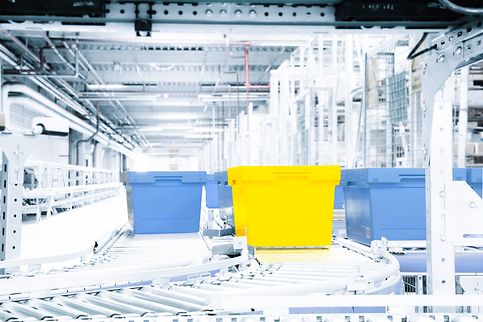Sustainable Reusable Plastic Containers
Returnable and Robust
These days, eco-conscious, long-term thinking and action are decisive standard for many investments — both socially and professionally. In this interview, Dr. Armin Vogel, EVP Plastics at SSI SCHAEFER, explains how SSI SCHAEFER produces sustainable plastic containers for long-term logistics use.
Dr. Vogel, how can plastic and sustainability be compatible?
To answer this question, we must start by defining the kind of plastic we are talking about. Basically, there are two different kinds of plastic that could not be more different in terms of sustainability. On the one hand, there are consumer plastics that ultimately pollute our lands and waterways, causing significant ecological damage. This is a long-term problem.
On the other hand, products such as plastic containers can offer continuous usage, as well as recyclability. By using these products, we can reduce or even avoid packaging waste while conserving resources. Above all, the longevity of plastic constitutes a major advantage of returnable containers. In fact, this longevity means we truly are talking about sustainable solutions.
Yet when it comes to environmental protection, we must expand our scope beyond the material. Sustainable solutions are also critical for our customers when it comes to aspects such as ergonomic handling and protecting goods during transport.
How do longevity and efficiency interact in this regard?
Sustainability for us means finding the perfect solution for the customer. With customized packaging and dunnage, we focus on efficient protection for product transportation and storage. This ensures a reduction in transport and handling damage.
Thanks to our durable, returnable containers, we are effectively able to contribute to a long-term, sustainable solution for the customer. This eliminates the need for expensive, disposable packaging that damages the environment.
What’s more, we focus on efficient solutions with our space-saving containers. We think it is critical to use space efficiently — and not only during active utilization within the material flow. We extend this thinking to the return and storage of empty containers to conserve resources and save costs. Nestable or collapsible containers require less space and can be transported and stored in larger quantities for the production and logistics cycle.
However, SSI SCHAEFER not only pursues sustainability through a returnable container cycle - recycling also plays a crucial role:
What containers are produced using regranulate sourced from recycled plastics?
Almost all containers can have a percentage of regranulate. In our production, we try to implement this to the maximum extent possible by using recycled resources. The exceptions to this rule are for companies that explicitly request new material. Here, too, we apply our high-quality standards, focusing on environmental compatibility and conserving resources when selecting raw materials and the colors we use.
What does the recycling of containers look like exactly?
In addition to producing durable products, we support the customers in their ability to return used or damaged containers that we can then recycle into regranulate material. We melt this material down and shape it again – to create a new container out of recycled products.
In terms of quality, the containers with a percentage of recycled material are by no means inferior to a new product. To ensure this, we of course subject the returned material to a quality check, so that we only process high-quality resources.
How often can plastics be reused and how long are the containers in use?
We always mix a percentage of new material with recycled material in production. The percentage varies depending on the condition of the recycled material. So we can recycle as often as we like. Generally, containers are in use for around ten to twelve years. Our customer dm has been successfully using our returnable containers continuously since the nineties, so they are confident in the durability of our products. Packaging options such as cartons, on the other hand, are often damaged after the first use and then disposed of. Using strong containers is the best option for long-term use in any storage environment – whether in manual or fully automated storage and conveying systems.
Also, when it comes to new products or replacing components for our customers, we take care of the return, recycling and the creation of new dunnage and customized packaging. This way, we can ensure a resource-saving and sustainable cycle in our production.
Does the use of regranulate have an influence on the color of the containers?
That’s an unavoidable consequence. When the materials are produced and melted, the plastic automatically takes on a slightly darker color. So, it is simply not possible to produce all colors from the regranulate. Yellow, for example, must always be created from virgin material. Containers in darker colors, however, can easily be produced from regranulate.


